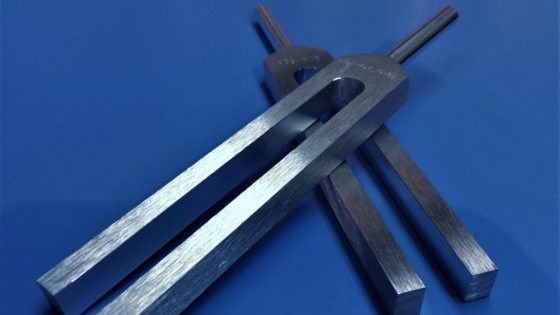Remember when we were kids and we learned about tuning forks used to tune our pianos or tuning the choir? Tuning forks serve many purposes even today, including being used by musicians, tuning pipe organs, bells, by police calibrating their radar guns, and by jewelers tuning watches. In the medical field, tuning forks are used to test hearing and sensory loss in the peripheral nerves. They are used readily in alternative therapies including polarity therapy, sound therapy, energy balancing therapy, acupuncture and acupressure, and Traditional Chinese Medicine.
Tuning forks were invented in England by John Shore who was a Flute and Trumpet player. The key to the tuning fork is that is has a “single” frequency and is one of the few sources that produces a “pure” sound. There are three basic types of sound. These are known as “linear, non-linear and pure.” Linear are produced by our voices, string instruments, and woodwinds. Non-linear sounds are created by drums, bells, gongs and sound bowls. Both linear and non-linear sound types produce several different frequencies at the same time with one note, which is known as “harmonics or overtones.”
There are many different types of tuning forks that either produce sounds that we can hear when struck and some that we do not unless the fork is brought closer to our ear. Some tuning forks we can place directly on the body to stimulate vibrations into the muscle tissues. For healing purposes and due to their purity and being harmonic free, the tuning fork allows for precise and practical ways to treat specific areas of the physical human or animal body.
Why and how does sound therapy work? Internal and external sound vibrations are absorbed by our body and these vibrations travel through the connective tissue, also known as meridians, down to cellular levels into our DNA. These waves have an effect on our electro-magnetic field. Because our body is made up of 70% water, sound travels through the body at a speed 4 times faster than thru air, being able to reach all extremities of our physical body. Emotions and illnesses are genetically encoded and stored in our central nervous system and can be trapped in our connective tissue. This “trapping of emotions” will harden and thicken the connective tissue over time causing it to dry out and not be able to vibrate as efficiently as it used to. Just like massage and touch, sound vibrations traveling through the tissue help to loosen this tightness and help the body to remember and calibrate back.
It is important in sound therapy to know what type of sound we want to use for optimal benefit and to achieve our desired results. The tuning forks, producing a “pure” sound and are especially beneficial for giving the body a clear and concise signal clearing congestion and areas within the body that are dampened or thickened. Linear sounds create harmonic patterns that are predictable, consistent and help thickened or blocked tissues to remember its inherit basic nature and fluid movements. Non-linear sounds with their unpredictability and clustering of harmonics, energize and activate tissue to free and clear up blockages due to their sharp and percussive tones and force.
The empirical studies documented by “School for Inner Sound,” show that blockages and tension stored in the body are more effectively released by the combination of integrating linear and non-linear sounds. This means that adding drum circles, gongs, and Tibetan sound bowls with voice and string instruments or woodwinds are very beneficial. Pure sounds produce best result when used as stand-alone techniques. Sound therapy is an easy way to integrate overall healing and balancing the energetic body for both animals and humans.

